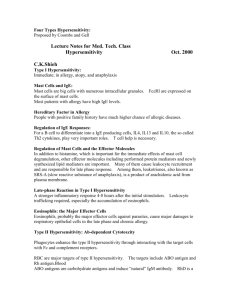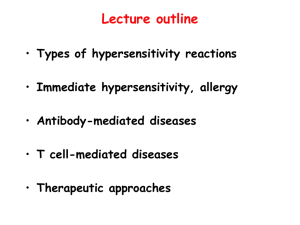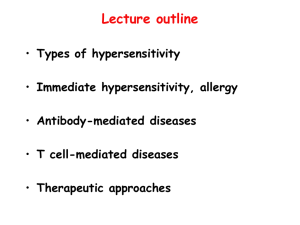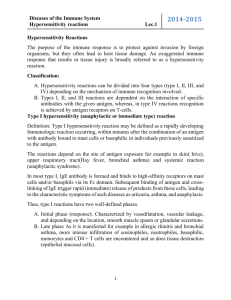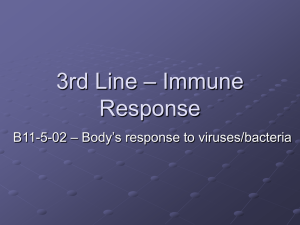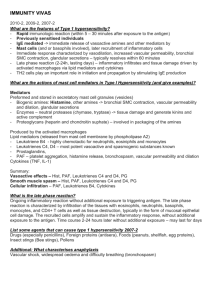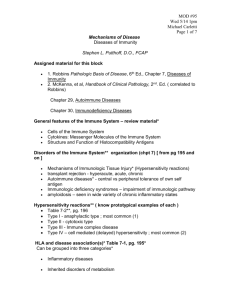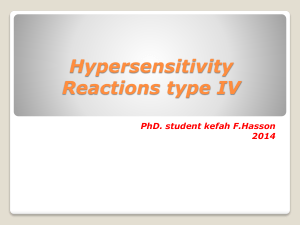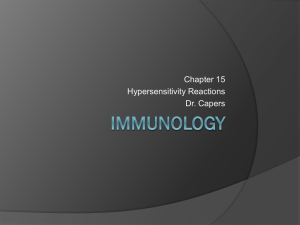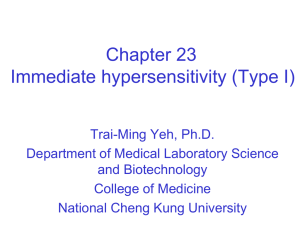Ch16
advertisement
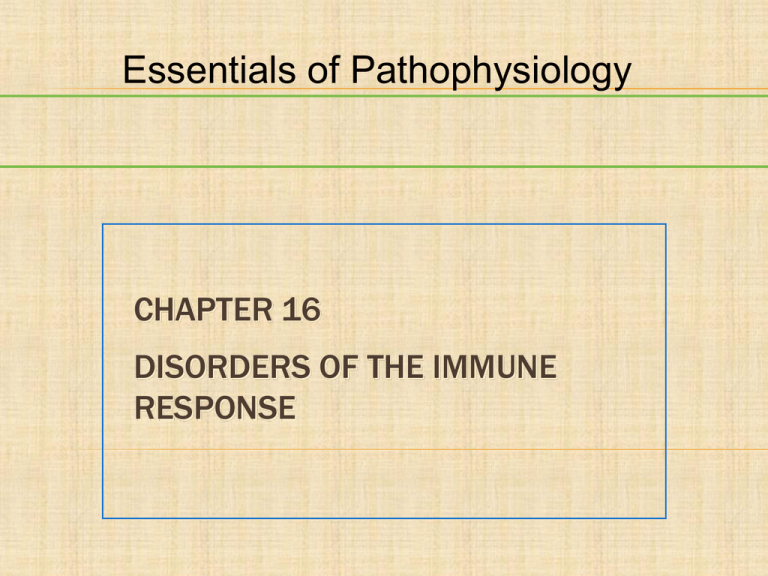
Essentials of Pathophysiology CHAPTER 16 DISORDERS OF THE IMMUNE RESPONSE PRE LECTURE QUIZ (TRUE/FALSE) F T T F F Allergic rhinitis is a systemic, life-threatening hypersensitivity reaction characterized by widespread vasodilation that leads to severe hypotension, airway constriction that causes difficulty breathing, and vascular permeability that causes swelling and obstruction of the upper airway. Virtually any food can produce an allergic reaction. In host-versus-graft disease, the immune cells of the transplant recipient attack the donor cells of the transplanted organ Severe combined immunodeficiency is a disorder that results from the loss of B-cell function, while all other immune function remains normal. The HIV-infected person can transmit the virus only when symptoms are present and the antibody test is positive. PRE LECTURE QUIZ Autoimmune Type __________ hypersensitivity responses result from immune responses to exogenous and endogenous antigens that produce inflammation and cause tissue damage. The _______________ test, a test in which purified protein derivative is injected under the skin, is an example of delayed-type hypersensitivity. Rheumatoid arthritis, insulin-dependent diabetes mellitus, ulcerative colitis, and myasthenia gravis are all examples of probable ___________________ disease. The HIV-infected person is at risk for many ___________ infections, potentially affecting the respiratory tract, the gastrointestinal tract, and the nervous system. _____________ tolerance refers to the inability to mount an immune response against a person’s own antigens. I Opportunistic Self tuberculin HYPERSENSITIVITY Excessive or inappropriate activation of the immune response The body is damaged by the immune response, rather than by the antigen (often called allergen) Discussion: How many different allergies do the members of this class have? What are their common signs and symptoms? Can the general process of inflammation explain these signs and symptoms? TYPE I HYPERSENSITIVITY Commonly called “allergic reactions” Systemic or anaphylactic reactions Local or atopic reactions (genetic) Rhinitis Food (hay fever) allergies Bronchial asthma Hives Atopic dermatitis (inherited) MECHANISM OF TYPE I HYPERSENSITIVITY Mast cell Allergen Allergen attaches to IgE IgE attaches to mast cell Sensitized Mast cell Mast cell degranulates TYPE I ALLERGIES ARE MEDIATED BY IGE What cells must be involved in this process: On the first exposure to the allergen? On repeated exposure? When What the allergen binds to IgE? inflammatory mediators are involved? How? QUESTION True or False. When mast cells degranulate, histamine is released. ANSWER True Rationale: Histamine is one of the first chemical mediators released during the inflammatory response as a result of mast cell degranulation. Mast-cell stabilizers (used to treat asthma) prevent the histamine from being released; antihistamines (used to treat allergies) compete with histamine for receptor sites, lessening the inflammatory response. ANAPHYLAXIS Systemic response to the inflammatory mediators released in type I hypersensitivity Histamine, acetylcholine, kinins, leukotrienes, and prostaglandins all cause vasodilation º What will happen when arterioles vasodilate throughout the body? Acetylcholine, kinins, leukotrienes, and prostaglandins all can cause bronchoconstriction º What will happen when the bronchioles constrict? SCENARIO A woman had an anaphylactic reaction and you are trying to explain the mechanism to her husband; he says he can see what you mean, but it does not make sense because what his wife experienced was different. She said her heart was pounding and she was terrified. Her eyes were dilated. She was shaking. Question: How could anaphylaxis cause these signs and symptoms? TYPE II HYPERSENSITIVITY Cytotoxic IgG or IgM attack antigens on cell surfaces Usually involves antigens on red or white blood cells Transfusion reactions Rh disease Drug reactions MECHANISM OF TYPE II HYPERSENSITIVITY Example incompatable blood transfusion Immunoglobulins Antigens introduced Immunoglobulins attach to antigens Complement activated Directly causes cell lysis Cell WBCs attracted lysis to eat cell SCENARIO A woman is Rh negative and her husband is Rh positive. She is pregnant with their first child and the doctor has prescribed RhoGAM, but the woman is confused about this. She says she does not want to take any drugs while she is pregnant—and besides, the doctor told her that her first child was not at much risk for Rh disease. Question: Why can’t she wait to take RhoGAM until she gets pregnant again and really needs it? RHOGAM a solution of IgG anti-Rh+ antibodies bind to, and lead to the destruction of, Rh+ red blood cells that have passed from the fetal circulation to the maternal circulation. prevents sensitization in a Rh negative mother to Rh+ antigens, Sensitization can cause hemolytic disease in the current or in subsequent pregnancies. QUESTION Why is type O blood considered the universal donor? a. It has both A and B antigens on the RBC. b. It has neither A nor B antigens on the RBC. c. It has no antibodies in the plasma. d. It has A and B antibodies in the plasma. ANSWER b. It has neither A nor B antigens on the RBC. Rationale: Antigens are the components that elicit an immune response (type II hypersensitivity reaction). Type O blood has no antigens on the RBC, so anyone can receive it because there is nothing to stimulate production of antibodies against it. The fact that type O blood has both A and B antibodies has nothing to do with creating the antigenantibody response. TYPE III HYPERSENSITIVITY Free-floating antigen + antibody circulating immune complex in the circulatory system Autoimmune vasculitis Glomerulonephritis Serum sickness Arthus reaction MECHANISM OF TYPE III HYPERSENSITIVITY • Immune complexes deposit on walls of blood vessels and activate complement Immunoglobulins Antigens • Blood vessels are damaged Immune complexes QUESTION True or False. Administration of certain antibiotics may result in type III hypersensitivity reaction. ANSWER True Rationale: A side effect associated with antibiotic administration (especially penicillin) is serum sickness, which may cause a type III hypersensitivity reaction. TYPE IV HYPERSENSITIVITY (CELLULAR IMMUNITY) Cell-mediated: sensitized T cells attack antigen Direct cell-mediated cytotoxicity Viral reactions Delayed-type hypersensitivity Tuberculin test Allergic contact dermatitis Hypersensitivity pneumonitis MECHANISMS OF TYPE IV HYPERSENSITIVITY TH1 cell Antigen Sensitized TH1 cell Activated Cytotoxic T cell Delayed-type hypersensitivity: TH1 cell secretes inflammatory mediators Direct cell-mediated cytotoxicity: Cytotoxic T cells kill tissue cells MECHANISMS OF TYPE IV HYPERSENSITIVITY An antigen enters the system The antigen is taken up, processed, and presented on the surface of APC and local cells APC cells present epitope to T4 helper cells T4 cells stimulate T8 cytotoxic cells to destroy local cells that have taken up the antigen. T4 cells release cytokines that initiated an inflamatory response Example: TB tine test T4 AUTOIMMUNE DISEASES Immune system attacks self-antigens Normally, self-reactive immune cells are killed in the lymphoid organs or suppressed by regulatory T cells In autoimmunity, this self-tolerance breaks down Immune system destroys body tissues Antitissue antibodies appear in blood (e.g., antithyroid antibodies) TRANSPLANT REJECTION Host-versus-graft disease (HVGD) Hyperacute Acute Circulating antibodies react with graft Exposure to transplant causes activation of immune system, especially T cells Chronic Blood vessels in transplant gradually damaged GRAFT-VERSUS-HOST DISEASE Transplanted immune cells attack host A recent study suggested that men who get bone marrow transplants from women might be more prone to GVHD than men who get bone marrow transplants from other men It also suggested that the more children a woman has had, the more likely her bone marrow will cause GVHD Discussion: Why might this be the case? QUESTION True or False. Patients who suffer from autoimmune disease have hypoactive immune systems. ANSWER False Rationale: In autoimmune diseases, the immune system is hyperactive—it attacks self-antigens and destroys its own body tissues. IMMUNODEFICIENCY Primary B-cell deficiencies Ig deficiencies T-cell deficiencies Combined immunodeficiencies Acquired AIDS HUMAN IMMUNODEFICIENCY VIRUS Transmitted by body fluids Sexual contact Breast milk Blood-to-blood contact º Contaminated needles º Transfusions º During pregnancy or birth HIV INFECTS A CELL Bind Binds to CD4 protein receptor Uncoat Integrate • Which of your body cells have CD4 proteins and CD4 receptors? • What does reverse transcriptase do? THE INFECTED CELL PRODUCES NEW HIV Polyprotein broken into subunits by protease Protein subunits are assembled into new virus particles Transcription Exit HIV may lie dormant in the genome for many years before it is activated to produce viral proteins Viral proteins are produced in a long string called a polyprotein QUESTION One AIDS drug is a fusion inhibitor (Fuzeon)—the drug prevents fusion of HIV to the CD4 receptor. In the previous slides’ illustrations, which step in the infection process is targeted by a fusion inhibitor? a. 1 b. 3 c. 6 d. 8 ANSWER 1 Rationale: In the illustration, step #1 marks the point of ATTACHMENT between HIV and the CD4 receptor site on the T lymphocyte. COURSE OF HIV INFECTION Primary infection phase Signs of systemic infection Seroconversion: immune system responds and antibodies against HIV appear (1–6 months) Latent period Virus is replicating, TH cell count gradually falls May last 10–11 years or longer Overt AIDS TH cell count <200 cells/mL or AIDS-defining illness AIDS-ASSOCIATED ILLNESSES Opportunistic infections Respiratory Gastrointestinal Nervous system AIDS dementia complex Malignancies Wasting syndrome SCENARIO A man was diagnosed as HIV-positive. He says this is nonsense because the test does not measure whether he is sick or not In fact, it means “his immune system is working” Question: Is he right?
